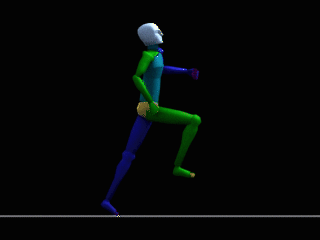
Kinesics
By Tan Wei Heng, Toh Wei Chuan,
Khor Yuk Liang, Ch'ng Liyang William
Siginificant Nonverbal Behaviours Involving The Feet
Happy feet are feet and legs that wiggle and/or bounce with joy. When people suddenly display happy feet - particularly if this occurs right after they have heard or seen something of significance –it’s because it has affected them in a positive emotional way.
First, a person may have naturally jittery legs, then it might be hard to distinguish happy feet from an individual’s normal nervous energy. If the rate or intensity of jiggling increases, however, particularly right after a person hears or witnesses something significant, it can be taken as happy feet.
Second, moving feet and legs may simply signify impatience. Our feet often jiggle or bounce when we grow impatient or feel the need to move things along. The rate of movement may increase as the person becomes more impatient.
Happy Feet
When feet shift direction, particularly toward or away from a person or object
We tend to turn toward things we like or are agreeable to us, and that includes individuals with whom we are interacting. In fact, we can use this information to determine whether others are happy to see us or would prefer that we leave them alone.
Assume you are approaching two people engaged in a conversation. These are individuals you have met before, and you want to join in the discussion, so you walk up to them and say “hi.” The problem is that you’re not sure if they really want your company. Is there a way to find out? Yes. Watch their torso and feet behaviour.
If they move their feet—along with their torsos—to admit you, then the welcome is full and genuine. However, if they don’t move their feet to welcome you but, instead, only swivel at the hips to say hello, then they’d rather be left alone.
The Knee Clasp
There are other intention movements of the legs that are associated with an individual who wants to leave his current location. Take note if a person who is sitting down places both hands on his knees in a knee clasp. This is a very clear sign that in his mind, he is ready to conclude the meeting and take leave.
Usually this hands-on-knees gesture is followed by a forward lean of the torso and/or a shift of the lower body to the edge of the chair, both intention movements.
Gravity-Defying Behaviours of The Feet
When we are happy and excited, we walk as if we are floating on air. We see this with lovers enthralled to be around each other as well as with children who are eager to enter a theme park.
Other examples:
- rocking up and down on the balls of our feet
- walking with a bit of a bounce in our step
Even when standing still, a person telling a story may inch up to a taller stance, elevating himself to emphasize his points, and he may do repeatedly. The individual does this subconsciously therefore these elevating behaviours are very honest cues, since they tend to be true expressions of the emotion attached to the story.
Leg Splay
The most unmistakable and easily spotted foot and leg behaviours are territorial displays. Most mammals, human or not, can become territorial when they are stressed or upset, when they are being threatened, or, conversely, when they are threatening others. When two people face off in disagreement, you will never see their legs crossed so that they are off balance. The limbic brain simply will not allow this to take place.
There are, of course, times when a leg splay can be used to your advantage—specifically, when you want to establish authority and control over others for a positive reason. Female law enforcement officers go through courses on how to use the leg splay to establish a more aggressive stance when responding to unruly crowds in the line of duty. Standing with their feet together (which is perceived as submissive) sends the wrong kind of signal to a would-be antagonist. By moving their feet apart, they can take a more dominant, “I am in charge” stance, which will be perceived as more authoritarian and thus help them be more effective in controlling unruly individuals.
Feet/Leg Displays of High Comfort
Careful observation of the legs and feet can help you determine how comfortable you are around somebody else and vice versa. Leg crossing is a particularly accurate barometer of how comfortable we feel around another person; we don’t use it if we feel uncomfortable. We also cross our legs in the presence of others when we are confident—and confidence is part of comfort.
If you see two colleagues talking to each other and they both have their legs crossed, you'll know they're likely to be comfortable with each other. First, this shows a mirroring of behaviours between two individuals (a comfort sign known as isopraxism) and second, because leg crossing is a high comfort display.

----------------------------------------------------------------------------------------------------------------------

----------------------------------------------------------------------------------------------------------------------

----------------------------------------------------------------------------------------------------------------------------------------------------------------
----------------------------------------------------------------------------------------------------------------------------------------------------------------

----------------------------------------------------------------------------------------------------------------------------------------------------------------
We usually cross our legs subconsciously in favour of the person we like the most. In other words, we cross our legs in such a way so that we tilt toward the person we favour. This can provide some interesting revelations during family gatherings. In families in which there are multiple children, it is not unusual to have a parent reveal a preference for one child over another by crossing legs so that they tilt toward the child they favour.
